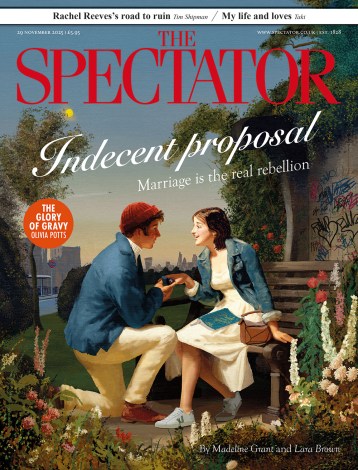
Now here’s a combination you never thought you’d see, not least because one of them is dead: Maurice Sendak and Stephen King. But there they are in Hansel and Gretel (Hodder Children’s, £20). Who knew that Sendak had illustrated Grimm, or that Mr Horror wrote fairy tales? It turns out that Sendak created sets for the Humperdinck opera, and King writes to these illustrations, which loom large and dramatic. King says that he has always been attracted both to fairy tales and to Sendak, and that one image especially that spoke to him was
the infamous candy house becoming a terrible face. I thought: this is what the house really looks like, a devil sick with sin, and it only shows that face when the kids turn their backs… To me it was the essence of the story – a sunny exterior, a dark and terrible centre and brave and resourceful children.
A cracker.
A more familiar pairing is Michael Rosen with Helen Oxenbury – in whose illustrations there is only goodness and innocence. The pair who gave us We’re Going on a Bear Hunt have collaborated again on Oh Dear, Look What I Got! (Walker, £12.99), in which a little boy is misheard in the shops and ends up with a menagerie. It’s very reminiscent of Rod Campbell’s Dear Zoo and seems destined for joyful repetition.
The pictures in Gordafarid and the Scent of Jasmine (Chichka Press, £14.99) are like monochrome Persian miniatures with lots of things happening on the page. Fatemeh Zoobinparan’s charming, busy little figures alternating with bold images illustrate a simple story based on ‘a dark chapter in [Persian] history when we confronted a cruel creature known as the Terrible Deev’. He peeps round the pages and roars, but is defeated by enterprising little girls.
Lauren O’Hare has illustrated a charming edition of Oscar Wilde’s Stories for Children (Little Island, £19.99). ‘The Selfish Giant’ is, as Walter Pater observed, ‘perfect of its kind’, with its evocation of Christ in ‘the print of two nails’ on the little boy’s palms. Other stories can be a little arch, but as Colm Toibin reminds us in his introduction: ‘When fairy tales were out of fashion in England, Wilde came from Ireland where the re-telling of old stories and their re-creation was becoming part of the cultural revival.’
Nicolette Jones’s edition of The Velveteen Rabbit & Other Classic Children’s Stories (Macmillan Collector’s Library, £20) brings together some of the best stories with, crucially, the original illustrations – by Isobel and John Morton-Sale for Eleanor Farjeon, and Ernest Shephard for Kenneth Grahame’s ‘The Reluctant Dragon’. Margery Williams’s ‘The Velveteen Rabbit’ wouldn’t be half as good without William Nicholson’s pictures.
The worst behaved pupils end up on Sin Bin Island, where there are aggressive spiders and a monster turtle
Frank Cottrell-Boyce’s happy geniality invests everything he writes, and so it is with The Blockbusters! (Macmillan, £12.99), which somehow combines the grim business of not having much money or a home with a fairy story in which an English class and their teacher go from a trip to Stratford to Hollywood and end up at the Oscars. It’s fantastical, but rooted in a reality with which many children are familiar:
We hadn’t had anything to eat since school. Uncle Miles took the light off his bike and we searched the tins in the kitchen. We decided that cold tomato soup would probably taste better than cold beans.
It still has a happy ending.
Doug Naylor’s Sin Bin Island (David Fickling, £7.99) is a boarding school adventure. The Correctional Orphanage for Wayward Boys and Girls has a pirate curriculum and our hero, Digs, ends up on Sin Bin Island for the worst behaved pupils, with aggressive spiders and a monster turtle. His adventures are framed by an heirloom of a wooden soldier, which turns out to be a set of nesting dolls, each with a note anticipating Digs’s next move. It’s gripping and funny and really all about friendship.
To say that Katherine Child’s The Notted Island (Flying Eye Books, £16.99) is an oddity doesn’t quite do justice to the charm and strangeness of a world based on a word: ‘Notte/Verb: The act of drawing the fabric of the night across the sky at close of day, or removing it at dawn.’ The notte (‘one who nottes’) of Last Island is becoming more erratic in her timing, so an intrepid girl, Tisky, decides to alert her to the threat from a sinister salesman who wants to sell an automated system for opening and closing the night sky. On her way, she picks up a shadow from a sundial, Jinks, for company. Like Alice’s Adventures in Wonderland, the fantasy is grounded in Tisky’s sturdy common sense and in vivid illustrations.
Peter Burns’s Shadow Thieves (Farshore, £7.99) is another boarding school story, except it’s a school in a remote mountain village for young thieves, assassins and spies – Hogwarts gone to the dark side. Tom, a 13-year-old escapee from a workhouse, has no choice but to sign up and has to deal not just with bullies but the far more sinister ambitions of those running the school. Completely thrilling.
Riverskin (Walker, £7.99), a first story by Mike Edwards, concerns a young girl, Tess, who lives below the banks of a river with her weird, green-skinned Aunt Peg and is forever menaced by Unkle Darkwater, the chained monster in the chamber below. It’s an oddity not only in subject matter but in its vivid language: ‘I soft-pad across kitchum floor, spreading my toe-webbing to cush my steps.’ Will Tess ever escape?
For children of a scientific bent, Raman Prinja’s Wonders of the Moon (Wayland, £16.99), covers every aspect of our lunar neighbour. The bad news is that the moon is moving away from us and will be swallowed up by the sun in five billion years. Otherlands by Tom Halliday (Penguin, £20) is a fascinating account of the vanished worlds of pre-history, with tips for surviving mass extinction events and fine dinosaur pictures by Gavin Scott.
Kevin Crossley Holland’s Kata & Tor (Walker, £7.99) is an adventure set during the Norwegian King Harald Hardrada’s invasion of northern England in 1066, with the other conqueror offstage. Hardrada’s bastard son Tor is sent ahead as a scout and encounters a spirited Anglo-Saxon girl named Kata. It’s a vivid evocation of time, place and atmosphere. Rosemary Sutcliff’s Sun Horse, Moon Horse (Manderley Press, £19.99) is set in an even more distant past, when the White Horse of Uffington was (perhaps) made by the son of the chief of the embattled Iceni tribe. It’s a tale of defeat and sacrifice, but of liberation, too. What a supreme storyteller she was.
Lamberto, Lamberto, Lamberto (Pushkin, £21.99) is Gianni Rodari’s captivating account of the Benjamin Button-like figure of a magnate who discovers the secret of rolling back the years. Translated from Italian by Antony Shugaar, it is very, very funny, and has arrestingly geometric illustrations by Roman Muradov.
Finally, there’s a new edition of The First Christmas (Penguin, £12.99), with Jan Pienkowski’s utterly lovely silhouette illustrations and the text of the King James Bible. Heavenly.








Comments